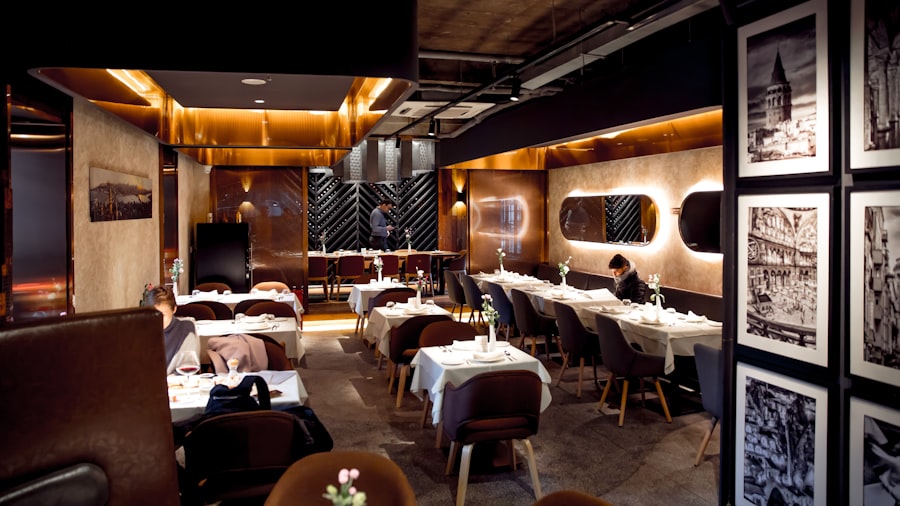In the digital age, the significance of Search Engine Optimization (SEO) for restaurants cannot be overstated. As consumers increasingly turn to the internet to discover dining options, a restaurant’s online visibility directly impacts its foot traffic and overall success. SEO encompasses a variety of strategies aimed at improving a restaurant’s ranking on search engine results pages (SERPs).
When potential customers search for terms like “best Italian restaurant near me” or “top-rated sushi in [city name],” restaurants that have effectively implemented SEO strategies are more likely to appear at the top of the results, thereby attracting more patrons. Moreover, restaurant SEO is not just about visibility; it also plays a crucial role in shaping a restaurant’s brand identity. A well-optimized website can convey professionalism and credibility, which are essential in a competitive market.
By ensuring that their online presence is optimized for search engines, restaurants can create a strong first impression that resonates with potential customers. This is particularly important in an industry where word-of-mouth and online reviews can significantly influence consumer choices. Therefore, understanding and implementing effective SEO strategies is vital for any restaurant aiming to thrive in today’s digital landscape.
Key Takeaways
- Restaurant SEO is crucial for increasing online visibility and attracting more customers.
- Identifying target keywords and phrases is essential for optimizing restaurant website content.
- Creating engaging and relevant content helps to improve search engine rankings and customer engagement.
- Optimizing local SEO is important for increasing restaurant visibility in the local area.
- Utilizing social media can improve SEO and engage with customers, leading to increased visibility and customer loyalty.
Identifying Target Keywords and Phrases
The foundation of any successful SEO strategy lies in identifying the right keywords and phrases that potential customers are using to search for dining options. This process begins with thorough keyword research, which involves analyzing search trends, competitor keywords, and customer behavior. Tools such as Google Keyword Planner, SEMrush, and Ahrefs can provide valuable insights into what terms are being searched most frequently in a specific geographic area.
For instance, a local pizzeria might discover that terms like “pizza delivery [city name]” or “best pizza near me” are highly searched, indicating a clear opportunity to optimize their content around these phrases. Once the target keywords have been identified, it is essential to incorporate them strategically throughout the restaurant’s website. This includes placing keywords in key areas such as page titles, meta descriptions, headers, and within the body content itself.
However, it is crucial to maintain a natural flow of language; keyword stuffing can lead to penalties from search engines and deter potential customers. Additionally, long-tail keywords—more specific phrases that typically have lower search volume but higher conversion rates—should not be overlooked. For example, instead of just targeting “Italian restaurant,” a restaurant could focus on “family-friendly Italian restaurant with outdoor seating,” which may attract a more specific audience.
Creating Engaging and Relevant Content

Content is king in the realm of SEO, and for restaurants, creating engaging and relevant content is paramount. This involves not only providing information about the menu and services but also crafting narratives that resonate with the target audience. Blog posts about seasonal ingredients, behind-the-scenes looks at the kitchen, or stories about the restaurant’s history can engage customers and encourage them to share this content on social media platforms.
Such engagement not only enhances brand loyalty but also signals to search engines that the website is a valuable resource. In addition to written content, visual elements play a significant role in engaging potential diners. High-quality images of dishes, videos showcasing food preparation, or virtual tours of the restaurant can enhance user experience and keep visitors on the site longer.
This increased dwell time can positively impact search rankings. Furthermore, incorporating user-generated content—such as photos shared by customers on social media—can create a sense of community and authenticity around the brand. By fostering an environment where customers feel connected to the restaurant through engaging content, restaurants can build lasting relationships that translate into repeat business.
Optimizing Local SEO for Restaurant Visibility
Local SEO is particularly crucial for restaurants, as most diners are searching for nearby options when they decide where to eat. Optimizing for local search involves several strategies aimed at increasing visibility within a specific geographic area. One of the most effective methods is claiming and optimizing a Google My Business (GMB) listing.
This free tool allows restaurants to manage their online presence across Google, including search results and maps. By providing accurate information such as location, hours of operation, menu items, and high-quality images, restaurants can enhance their chances of appearing in local searches. In addition to GMB optimization, local citations—mentions of the restaurant’s name, address, and phone number (NAP) on other websites—are essential for building credibility with search engines.
Consistency in NAP information across various platforms such as Yelp, TripAdvisor, and local directories helps establish trustworthiness. Furthermore, encouraging satisfied customers to leave reviews on these platforms can significantly boost local SEO efforts. Positive reviews not only enhance visibility but also influence potential diners’ decisions by providing social proof of the restaurant’s quality.
Utilizing Social Media for SEO and Customer Engagement
Social media platforms have become indispensable tools for restaurants looking to enhance their SEO efforts while engaging with customers. By maintaining an active presence on platforms like Instagram, Facebook, and Twitter, restaurants can share updates about new menu items, special events, or promotions that drive traffic to their website. Social media also serves as an excellent channel for customer interaction; responding to comments and messages promptly fosters a sense of community and encourages customer loyalty.
Moreover, social media can indirectly influence SEO by driving traffic to the restaurant’s website. When users share posts or engage with content that links back to the restaurant’s site, it signals to search engines that the content is valuable and relevant. Additionally, incorporating targeted hashtags can help reach a broader audience beyond existing followers.
For instance, using hashtags like #Foodie or #LocalEats can attract users searching for dining recommendations in their area. By leveraging social media effectively, restaurants can enhance their online presence while building meaningful relationships with their customers.
Building a Strong Online Reputation through Reviews and Ratings

Shaping Public Perception
In the restaurant industry, reputation is everything. Online reviews and ratings play a pivotal role in shaping public perception and influencing potential diners’ choices. Platforms like Yelp, Google Reviews, and TripAdvisor are often the first places consumers turn when researching dining options.
Actively Managing Online Reviews
Therefore, actively managing online reviews is essential for maintaining a positive reputation. Restaurants should encourage satisfied customers to leave reviews while also addressing negative feedback constructively. Responding to reviews—both positive and negative—demonstrates that the restaurant values customer feedback and is committed to improving its services.
The Power of Response
A thoughtful response to a negative review can turn a dissatisfied customer into a loyal patron if handled correctly. For example, acknowledging the issue raised by the customer and offering a solution or compensation shows that the restaurant cares about its guests’ experiences. Additionally, showcasing positive reviews on the restaurant’s website or social media pages can serve as powerful testimonials that attract new customers.
Implementing Mobile-Friendly SEO Strategies for On-the-Go Diners
With an increasing number of consumers using mobile devices to search for dining options while on the go, implementing mobile-friendly SEO strategies has become imperative for restaurants. A mobile-optimized website ensures that users have a seamless experience when accessing information about the restaurant from their smartphones or tablets. This includes having a responsive design that adjusts to different screen sizes, fast loading times, and easy navigation.
Furthermore, mobile users often seek quick information such as location, hours of operation, and menu items. Therefore, ensuring that this information is easily accessible on mobile devices is crucial. Implementing features like click-to-call buttons allows potential customers to contact the restaurant directly without having to manually dial the number.
Additionally, optimizing for local searches on mobile devices—such as using location-based keywords—can significantly enhance visibility among diners looking for nearby options.
Measuring and Analyzing SEO Performance for Continuous Improvement
To ensure that SEO efforts are yielding positive results, it is essential for restaurants to measure and analyze their performance regularly. Utilizing tools like Google Analytics provides valuable insights into website traffic sources, user behavior, and conversion rates. By tracking metrics such as organic search traffic and bounce rates, restaurants can identify which strategies are working effectively and which areas require improvement.
Moreover, monitoring keyword rankings over time helps assess whether targeted keywords are driving traffic as expected. If certain keywords are underperforming, it may be necessary to adjust content or explore new keyword opportunities based on changing consumer behavior or trends in the industry. Regularly reviewing online reviews and social media engagement metrics also provides insights into customer sentiment and areas where service may need enhancement.
By adopting a data-driven approach to SEO performance measurement, restaurants can continuously refine their strategies to stay competitive in an ever-evolving digital landscape.
If you’re interested in learning more about the impact of SEO on local businesses, check out this article on Geo vs. SEO: What’s the Difference and Why Does It Matter?. This piece delves into the importance of geographic targeting in search engine optimization and how it can help businesses attract more customers in their local area. It’s a great companion read to Serving Up Success: Effective Restaurant SEO Strategies That Attract Diners.
FAQs
What is restaurant SEO?
Restaurant SEO refers to the process of optimizing a restaurant’s website and online presence to improve its visibility in search engine results. This involves using relevant keywords, creating high-quality content, and implementing other strategies to attract more diners to the restaurant’s website.
Why is restaurant SEO important?
Restaurant SEO is important because it helps potential diners find a restaurant’s website when they search for relevant keywords or phrases. By improving a restaurant’s visibility in search engine results, SEO can attract more traffic to the website and ultimately lead to more reservations and diners.
What are some effective restaurant SEO strategies?
Effective restaurant SEO strategies include optimizing the website for local search, creating high-quality and relevant content, obtaining backlinks from reputable sources, and ensuring the website is mobile-friendly. Additionally, optimizing the restaurant’s Google My Business listing and managing online reviews can also improve SEO.
How can restaurant SEO attract more diners?
By implementing effective SEO strategies, a restaurant can improve its visibility in search engine results, making it easier for potential diners to find the restaurant online. This can lead to increased website traffic, more reservations, and ultimately more diners visiting the restaurant.
What are some common mistakes to avoid in restaurant SEO?
Common mistakes to avoid in restaurant SEO include keyword stuffing, neglecting local SEO, using low-quality or irrelevant content, and ignoring the importance of mobile optimization. It’s also important to actively manage online reviews and ensure the restaurant’s information is accurate and up-to-date across all online platforms.

